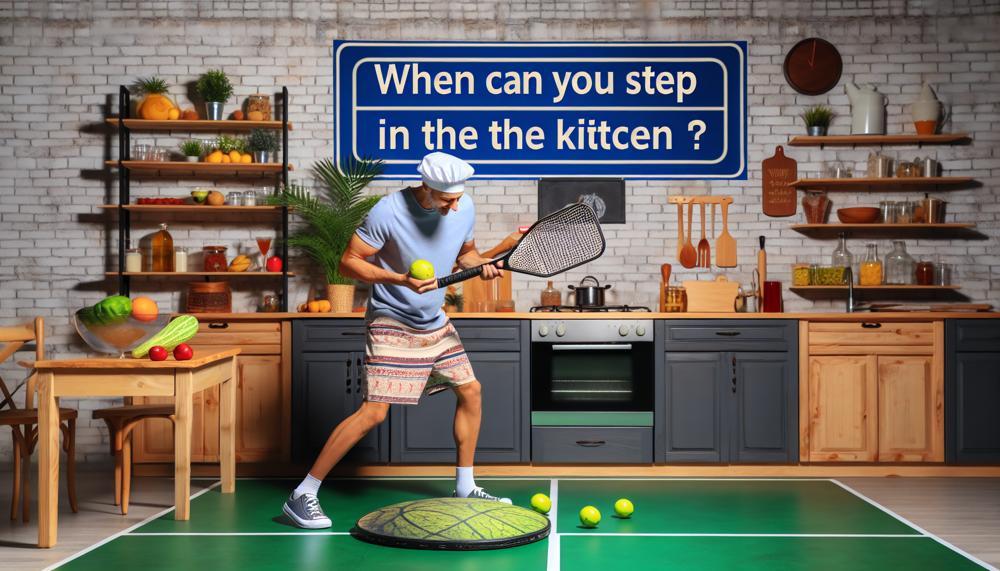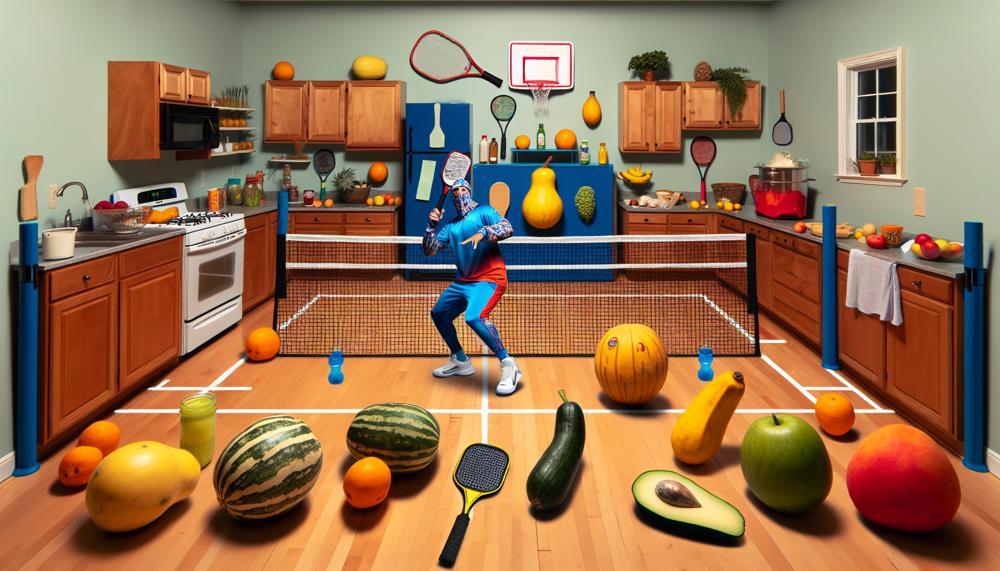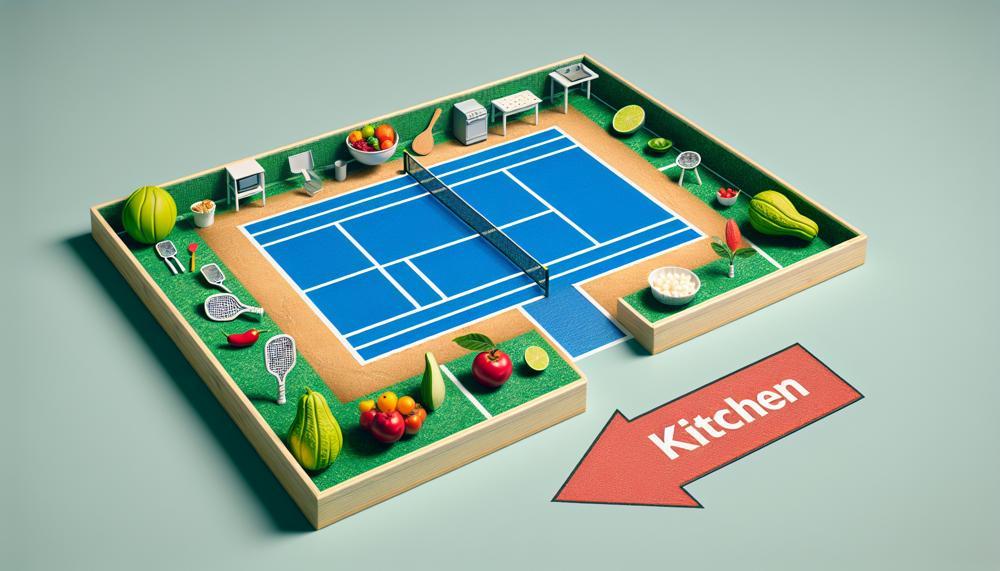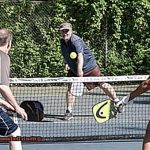Do you find yourself constantly disrupting your partner’s shots during pickleball games?
Or are you struggling to figure out the right moment to step into the kitchen without incurring a fault? Don’t worry, you’re not alone.
The kitchen, also known as the non-volley zone, can be a challenging element of pickleball to conquer. But fear not, my fellow pickleball aficionados.
So grab your paddles and let’s sizzle up some tips.
Table of Contents
What is the pickleball kitchen rule?
As a fellow enthusiast of racket sports, you are likely familiar with the exhilarating game of pickleball. This lively, dynamic sport has gained significant traction in recent years, and for good reason.

Combining elements of tennis, badminton, and ping-pong, pickleball offers a refreshing and thrilling experience suitable for players of all ages and skill levels.
However, as with any sport, adherence to rules and regulations is crucial to ensuring fair play. One such rule that holds paramount importance in pickleball is the kitchen rule, also known as the non-volley zone rule.
This rule dictates the permissible areas on the court where players can position themselves while hitting volleys—shots made while the ball is mid-air before bouncing.
So, what precisely is the pickleball kitchen rule, and how does it affect hitting volleys? Let’s dive deeper into its intricacies.
The Kitchen Rule Demystified
In pickleball parlance, the kitchen refers to a 7-foot-wide area on either side of the net that extends to each sideline. According to this rule, players are prohibited from stepping into or making contact with this area while volleying. This includes any object physically connected to them, be it their partner or their momentum, that may carry them into the kitchen after hitting a volley.
To put it simply, if you are in the kitchen while making contact with the ball during a volley, it is considered a fault. The aim of this rule is to curb any unfair advantage a player may gain by being too close to the net.
The Impact of the Kitchen Rule on Volleys
Now that we have decoded the kitchen rule, let’s unpack its implications for hitting volleys in pickleball.
- No initiating volleys from within the kitchen: It is essential to note that even if you jump and land outside of the kitchen while hitting a volley, it is still considered a fault. To execute a clean and legal volley, you must first reset your stance outside of the kitchen.
- Post-bounce entry into the kitchen is permissible. If the ball has bounced before you enter the kitchen, it is allowed. However, ensure that you do not linger in the kitchen for an extended period, as it limits your options for returning shots.
- Toeing the line: To optimize your positioning during dinking rallies, it is advisable to stand just behind the kitchen line.
Here are Five Important Pickleball Kitchen Facts
The Kitchen: The Non-Volley Zone
Pickleball players know it as the kitchen, but its official name is the non-volley zone (NVZ). This area, measuring 7 feet on each side of the net, is a crucial part of the game. It prevents players from attacking with aggressive volleys, promoting a more strategic style of play. This adds an exciting challenge to the game.
The Unique and Challenging Kitchen Rule
Unlike other racket sports that allow free movement around the court, pickleball requires players to stay out of the designated non-volley zone unless the ball has bounced.
This rule demands quick reflexes and precise footwork, enhancing the physical and mental agility required to excel at this sport.
Fault: Stepping into the Kitchen Before Bounce
One of the most strict and challenging rules in pickleball is stepping into the kitchen before the ball has bounced. This results in a fault and a point for the opposing team.
Adjusting to this rule can be difficult for players transitioning from other racket sports where entering the non-volley zone is allowed. However, it adds an extra layer of excitement and strategy to the game.
Exceptions to the Kitchen Rule
While stepping into the kitchen before the bounce is usually a fault, there are exceptions to this rule. A player may enter this no-go zone if they are retrieving a ball that would otherwise go out of bounds or hit an object outside of the court, such as a tree or fence. However, they must immediately exit after hitting their shot; failure to do so will result in a fault.
Shots Can Still be Made from Within the Kitchen
Despite its name, entering the kitchen does not mean a player is out of play. They can still hit shots from within this zone as long as they do not violate any other rules, such as hitting a volley or a shot that bounces outside of the court. This adds more strategic opportunities for players to outsmart their opponents and win points.
In conclusion, the kitchen rule in pickleball is a unique and essential element of the game that all players must understand. It requires quick reflexes, precise footwork, and strategic thinking to master.
Pickleball Terms
In the fast-paced realm of pickleball, lies a diminutive yet formidable territory that holds the power to make or break a match – the kitchen. Referred to as the non-volley zone, this 7-foot expanse near the net requires dexterous footwork, swift reflexes, and strategic thinking. In this blog post, we will delve into the intricacies of this area of pickleball, its regulations, and how to excel in it.
What is the Kitchen in Pickleball?
The kitchen is a designated region on both sides of the net that stretches 7 feet from its edge. It is also known as the non-volley zone as players are prohibited from hitting the ball while airborne (volley) while standing in this zone. This rule adds an exhilarating element to the game and necessitates players to employ astuteness and precision when approaching the net.
Rules of the Kitchen
To triumph in pickleball, it is imperative to have a thorough understanding of the rules governing the kitchen. Here are some key regulations to bear in mind:
- No volleys allowed: As mentioned earlier, players are not permitted to strike the ball while airborne while standing in the kitchen. The ball must bounce before being struck.
- No touching the kitchen line: Players must refrain from touching or crossing over the kitchen line while hitting a shot. This rule applies even if their momentum carries them into the kitchen after hitting a shot.
- Exiting the kitchen: Players can enter the kitchen after the ball has bounced but must exit expeditiously. Prolonged stays in the kitchen can result in a fault.
- Serving from behind the baseline: During serving, players must stand behind the baseline and serve diagonally into their opponent’s service court. The ball must clear the kitchen line during a serve.
Mastering The Kitchen
Now that you are acquainted with the kitchen and its rules, let’s delve into some tips to help you become a master of this crucial area of the court:
- Practice footwork: In pickleball, footwork is paramount, especially in the kitchen. To avoid stepping into the kitchen while hitting a shot, practice your footwork and learn to control your movements.
- Utilize soft shots: With volleys prohibited in the kitchen, players must employ soft shots to keep the ball low and close to the net.
Pickleball Kitchen: What Is It?

For avid followers of racket sports, the buzz surrounding pickleball is hard to ignore. This fast-paced and exhilarating game has captured the hearts of many, thanks to its fusion of tennis, badminton, and ping pong elements. But amidst all the excitement lies a curious mystery – what exactly is the purpose of having a kitchen in pickleball? In this article, we will unravel the secrets behind this enigmatic pickleball kitchen and why it holds such an essential role in the game.
What is the Kitchen in Pickleball?
Known as the non-volley zone, the kitchen is a designated area on the court that extends seven feet from the net on both sides. A line delineates this area and acts as a barrier to stop players from gaining an unfair advantage by controlling the game with strong smashes or serves.
Why is the Kitchen Significant?
The kitchen in pickleball serves multiple purposes. Firstly, it promotes fair play by creating a level playing field for all players, regardless of their physical capabilities. By restricting how close players can get to the net, it ensures that no one has an unfair advantage.
Furthermore, the kitchen encourages strategic gameplay, forcing players to utilize a variety of shots to earn points. It challenges players to position themselves effectively on the court, avoiding stepping into the kitchen while still being able to deliver effective shots.
Mastering the Kitchen
Now that we understand the significance of the pickleball kitchen, you may be wondering how you can enhance your skills in this area. The key to mastering the kitchen lies in footwork and shot selection.
Footwork plays a crucial role in pickleball as it allows players to swiftly move around the court and position themselves for different shots. When it comes to the kitchen, players must have quick and efficient footwork to avoid stepping into it.
Shot selection is equally vital in the kitchen. Players must learn to execute a variety of shots, such as dinks, volleys, and lobs, to keep their opponents on their toes and prevent them from dominating the game.
In conclusion, the pickleball kitchen holds a significant role in the game. It promotes fair play, strategic gameplay, and challenges players to improve their footwork and shot selection.
A look at the pickleball kitchen rules
Pickleball, a well-liked racket sport that skillfully blends elements of tennis, badminton, and ping pong, has captured the hearts of players of all ages and proficiency levels. Its distinctive court design and regulations offer a stimulating yet enjoyable experience for its players. Among the crucial components of this game is the kitchen or non-volley zone, which holds the key to fair play, strategic gameplay, and masterful footwork.
In this piece, we will delve deeper into the intricate kitchen rules in pickleball and the consequences that come with violating them.
Understanding the Complexity of Kitchen Rules
The kitchen is a seven-foot area on both sides of the net that stretches from the net to the service line. This zone is visibly marked with a line on the court to signify its boundaries. As per pickleball guidelines, players are not permitted to enter the kitchen or be in contact with its line while volleying the ball. They must also wait for the ball to bounce before stepping into the kitchen to make a shot.
Repercussions of Infringing upon Kitchen Rules
As previously mentioned, entering the kitchen while volleying or volleying from within it results in a fault. This means that you forfeit your serve, and the ball goes back to your opponents. This rule is in place to prevent players from gaining an undue advantage by getting too close to the net, leading to an unfair match.
But why is it so imperative to adhere to these regulations? The answer lies in maintaining equitable play and strategic gameplay. Stepping into the kitchen gives players an unfair upper hand as they can effortlessly intercept shots from their adversaries. This can result in an unbalanced and less enjoyable match for both teams.
Furthermore, disregarding these rules can also lead to injuries. Since players are not allowed to make overhead shots while in the kitchen, stepping into it while attempting a shot can result in accidental contact with the opposing team, causing injuries.
Mastering the Kitchen Rules
To excel in pickleball, it is vital to master the rules and techniques of playing in the kitchen. This entails having exceptional footwork and knowing when to enter the kitchen and when to abstain. Additionally, practicing proper body positioning and control while making shots from the kitchen can significantly enhance your gameplay.
What you can do in the kitchen?
The kitchen zone, also known as the non-volley area, is a pivotal aspect of every pickleball match. Despite its seemingly small size, it plays a crucial role in determining the outcome of the game. As an expert in racket sports, I am here to illuminate the purpose of the kitchen zone and the various actions one can take within it.
So, What Exactly Can You Do in the Kitchen?
Return Crafty Shots
The primary function of the kitchen area is to allow players to return crafty shots, often referred to as dinks. These shots are played near the net and require precise placement and control. By permitting players to enter the kitchen zone, they have a better chance of returning these tricky shots without letting them bounce twice on their side.
Prohibit Volleys
Another vital purpose of the kitchen area is to prohibit volleys. In pickleball, a volley occurs when a player strikes the ball before it bounces on their side of the court. The non-volley zone forces players to let the ball bounce before hitting it, making the game more strategic and less reliant on raw power.
Introduce Complexity to Gameplay
The kitchen area adds an additional layer of complexity to pickleball gameplay. It demands quick reflexes and adept footwork to efficiently navigate in and out of the non-volley zone. This adds a sense of thrill and unpredictability to the game, keeping players on their toes at all times.
Promote Fairness
Pickleball is founded on principles of fairness, and the kitchen rules play a significant role in upholding this value. By limiting volleys and mandating players to stay behind the non-volley zone while executing short shots, it ensures that no player has an unfair advantage over another.
Encourage Strategic Thinking
Lastly, the kitchen area promotes strategic thinking. As mentioned earlier, it compels players to rely on placement and control rather than sheer force. This feature of the game makes it more about strategy and less about physical strength, making it a sport that players of all ages and skill levels can enjoy.
But Remember, There are Consequences to violating Kitchen Rules
As with any sport, breaking the rules carries consequences. In pickleball, if a player steps into the kitchen while volleying or hitting a short shot, it results in a fault.
Toe the line
The concept of “toe the line” is a crucial one in the world of pickleball, a fast-paced and popular racket sport that combines elements of tennis, badminton, and table tennis. But what exactly does it mean to “toe the line” in pickleball, and why is it so important?
In simple terms, “toe the line” refers to the act of positioning oneself as close to the non-volley line as possible without stepping into the kitchen zone. The non-volley line, also known as the kitchen, is a seven-foot-wide area on each side of the net that prohibits players from hitting volleys or stepping inside with their feet.
So why is it essential to toe the line in pickleball? The main reason is to avoid committing a fault, which can result in points for your opponent. Stepping into the kitchen while hitting a shot or crossing the non-volley line with any part of your body or clothing is considered a fault. This emphasizes the significance of staying behind the line during gameplay.
But that’s not all—toeing the line also allows you to maintain a strategic position on the court. By being close to the non-volley line, you can quickly react to shots and maintain control over the game. It also forces your opponents to hit more precise shots, giving you an edge.
To master the art of toeing the line, remember these tips: always keep your eye on the line, use a wide stance for balance, practice proper footwork techniques, and be mindful of momentum. With practice and precision, you can become an expert at “toeing the line” in pickleball and elevate your game to new heights.
Conclusion
In summary, the kitchen in pickleball may seem like a small and insignificant area on the court, but it holds great significance in the game. It not only promotes fair play but also requires strategic thinking and physical agility from players. As competitors, it is crucial to fully understand and abide by the rules of the kitchen to ensure a fun and competitive match.
From comprehending the purpose of the non-volley zone to mastering footwork and shot selection, there are various ways to excel in this vital aspect of pickleball. Always remember to “toe the line” and avoid making mistakes that could cost you points.






